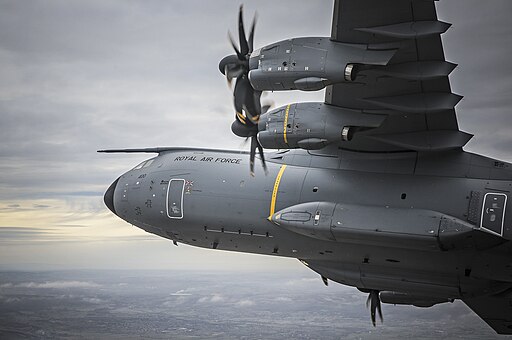A Royal Air Force (RAF)A400M Atlas transport aircraft has accomplished an extraordinary feat by embarking on the longest-ever flight of this aircraft type as part of the RAF deployment for Exercise Mobility Guardian 23. The Atlas, departing from RAF Brize Norton on July 3, completed a non-stop journey of 20 hours and 36 minutes, setting a new milestone in the aircraft’s history.

MoD/Crown copyright (2015), OGL 2, via Wikimedia Commons
During its remarkable flight to Guam, the A400M Atlas made three crucial refueling stops, ensuring a continuous and uninterrupted mission. The first refueling was executed over the Atlantic Ocean, with a Voyager from 10/101 Squadron departing from the UK. The second and third refueling maneuvers took place over Alaska, with a second Voyager operating from the United States Air Force Eilson Air Base fulfilling the critical role.
This historic flight also took the A400M Atlas closer to the North Pole, venturing over the Arctic ice cap, more than any previous flight of this aircraft type. This remarkable demonstration of the RAF’s air power projection capabilities highlights the speed, reach, and utility of the Air Mobility Force, enabling the swift deployment of aircraft, crews, and essential equipment to distant locations across the globe.
Air Commodore Anthony Lyle, the RAF’s Air Mobility Force Commander, emphasized the significance of Exercise Mobility Guardian as a premier training opportunity for the Air Mobility Force. He underscored the exercise’s ability to showcase the RAF’s operational prowess, highlighting their proficiency in rapidly conducting global air operations.
Exercise Mobility Guardian 2023, recognized as Air Mobility Command’s most extensive full-spectrum readiness exercise in its history, commenced on Jul. 5 in the Indo-Pacific region. Building upon previous iterations, this year’s MG23 aims to overcome the challenge of distance to deliver mobilization, deployment, and sustainment functions crucial for the Joint Force, allies, and partners in responding to worldwide challenges.
As a multinational endeavor, MG23 involves seven participating countries: Australia, Canada, France, Japan, New Zealand, the United Kingdom, and the United States. Approximately 70 mobility aircraft will operate across multiple locations spanning a vast 3,000-mile exercise area until July 21. With over 3,000 personnel directly supporting the exercise, MG23 expects to facilitate the participation of more than 15,000 U.S. forces and allied and partner personnel—significantly surpassing the scale of previous iterations.
Planning for this Pacific endeavor commenced in the spring of 2022, with more than 200 planners from across Air Mobility Command (AMC) collaborating to ensure seamless interoperability across joint and combined international forces. The exercise aims to enhance readiness skills and bolster interoperability among participating nations in various mission areas, including airlift, aerial refueling, aeromedical evacuation, command and control, and humanitarian and disaster assistance.
Exercise Mobility Guardian 23 coincides with a series of other exercises occurring throughout the Indo-Pacific region this summer. AMC’s pivotal role in enabling the efficient maneuvering of forces underscores the significance of logistics and realistic interoperability in this critical region.
Lt. Col. Jake Parker, Exercise Director for MG23, emphasized that this exercise serves as a proving ground for the Mobility Air Force (MAF), where new standards of readiness are tested through the application of flexible and agile concepts. This forward-thinking approach ensures thatthe MAF, alongside the Joint Force, allies, and partners, can effectively overcome transnational security challenges while redefining what MAF readiness entails.
For more information, hit the Source below
Would A400M be good for subcontracting to Lockheed Martin for USAF use? Pros and cons?
Failing that, isn’t it time to consider replacements for the C-5B , C-17 and the much used C-130 in all variations? Both the C-5B and C-17 have no production line to make new units and the C-130J is still being made for all users.
Time to ask all innovators to step in and propose credible replacements for all transport aircraft including the much loved C-130J.